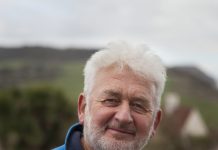Robin Mills went to Bradford Abbas, Sherborne, to meet Dawn Warr. This is her story.
“When I was born in 1960, my dad was under-keeper for Lord Normanton at Somerley, near Ringwood. I’ve got two brothers; Harry, 9 years older than me, who’s a part-time keeper and river keeper for Lord Digby at Wool, and Mick who works on Port Elliott estate down at St Germans, in Cornwall. When I was 18 months old, Dad took a job as head keeper on the Pentillie Estate, on the banks of the Tamar River. So I grew up there, on the tidal part of the Tamar, and when we came home from school we’d be straight out fishing; absolutely wonderful, although our house was very remote and about a mile uphill to catch the school bus. I went to primary school at St Mellion, then the comprehensive at Callington.
The interest in keepering, wild birds, tracks, shooting and fishing all came from growing up in Cornwall. With my two brothers, I went everywhere and did everything with Dad, and they taught me to shoot and fish, and identify wild birds and animal tracks. I never played with dolls, always wanted to be with my Dad or my brothers, really quite a wild outdoor girl, living a wonderful childhood which is hard to imagine happening these days. In 1974, when I was 14, Dad took on the job of head keeper at Melbury Park, near Evershot, and that was how I came to Dorset. Melbury has a large deer park; when we were in Cornwall, we only saw the occasional red deer, but now there’s plenty of roe and fallow as well. Also, when we were there in the ‘60s, the grey squirrel was still heading south, and would swim the River Tamar at high tide—250yds across—in its migration. In Dorset, I went to school in Sherborne, to what was St Aldhelm’s, and hated every minute of it. The exasperated English teacher asked my Dad if there was anything I was good at, and Dad said, “Well, she can skin a deer.” I was only there a year and a half, and left school just before my 16th birthday.
I was lucky that just after I left school, the under-keeper’s job at Melbury came up; I applied for it and got it. I have no doubt that if my dad hadn’t been the head keeper at the time I wouldn’t have been successful, because the likelihood in those days of a woman getting any kind of keeper’s job was very remote. I had that job for 18 years. It was a private shoot with guests, so there were no really big shoot days like a commercial operation; we hatched all our own eggs, reared our own birds, did the whole job. As time went on, I took on more responsibility because Dad’s health was deteriorating. When he retired in ’92, I took over as head keeper. At that time I was the first woman head keeper in the country.
To try and briefly describe the keeper’s work through the year; in early spring you have to catch up the laying hen pheasants, and some cock birds which every other year come from another estate, to change the blood line. Laying starts at the end of March, and the eggs take 24 days to incubate, during which time rearing pens are prepared for the young birds, which require a heat source in their early days. Gradually the birds are hardened off to the weather as they grow, then at 6-7weeks old they go to the release pens. These are pens with an open top, out on the shoot, fenced to 6ft high, and with an electric fence round the outside to stop foxes from digging their way in. This is where the birds grow to adulthood, protected from most predators—although buzzards can occasionally find their way in—but there should be plenty of cover in the pens, with trees for the birds to roost in. There are pop holes round the outside of the pens allowing the birds to come back in if they should fly out, a kind of one-way system. So the keeper will check the pens, feed and water the birds at least once a day, and all the time the birds are gradually getting established in the area. After that, feeders will be put out in the woods, and maybe some straw put out in the rides, to encourage the birds to spread out over a bigger area, during which time preparations are made for the oncoming shooting season which starts for pheasants on October 1st—although most shoots won’t start until towards the end of the month. The keeper’s job on a shoot day is to produce as high a quality flying bird as possible, which hopefully comes from a combination of where the release pens are sited, and the strategy for the direction and sequence of the beaters’ drives. The keeper’s also got to make the day a well-organised one, but fun for all concerned. Good management of a shoot the year round has great advantages for the whole countryside; the numbers of wild birds that benefit from the feeding is huge, wonderful to see, and we also do quite a lot of rotational coppicing in the woods to improve the cover, which shelters wild and game birds alike. Attitudes have changed, too, amongst keepers. In the 50’s any bird with a hooked beak—birds of prey, etc—was considered a threat. Nowadays, because we rear so many of our own birds, and because we provide much more cover, there’s very little trouble from predators. Poachers, though, are a big problem in some places. Not that they’re after pheasants these days; deer poaching is mainly about either shooting one to sell at the back door of a dodgy hotel, or in larger numbers for the trophy heads.
By 1994, the circumstances of my job had changed, so I decided to leave and become self-employed. I now run a shoot at John Morris’s Huish Farm at Sydling St Nicholas, since 2000 I think, and help out at others. It’s a small syndicate shoot for friends, with 8 members. We share all the work between us; we rear all our own birds, 600 pheasants and 200 partridge. We have a wonderful time up here, a very friendly shoot, great fun, completely different to one place I know where there’s still distinct segregation between guns and beaters. I help with loading and beating on one or two shoots. At John’s the syndicate members all do the work, so we all have to feed one day a week, and on a shoot day the bag is immaterial. If they’ve only shot a few they’re just as happy as if they’ve shot dozens. And we’re all from different backgrounds, not just country people; we have a kitchen fitter, a carpet layer, a builder, and a window cleaner, as well as some farmers. It is still very expensive, but it’s no longer the exclusive elite pastime it was.
As a little girl at school I was always good at art. I could draw well, but only the trees and animals I saw every day, not the subjects the teachers asked me to draw. So as a keeper I’d sketch the beaters’ dogs for them, and soon I found a ready market for animal portraits. I joined a friend with a stand at country shows, displaying my taxidermy work, and I’d be drawing the animals while I was there. People love to see the work actually in progress; they see me start a picture, then they come back later in the day to see the finished article, which is great. So I go to all the local shows, people maybe take a card when they’re there, then look at my website later and get in touch that way. My work’s all pet portraits, in chalk pastels.
Being self-employed has given me more time for the taxidermy, which I started as a hobby in 1982. I bought a book on how to do it, because I really liked the stuffed animals I’d seen at my brother’s place. There were the stoats and mink I’d caught as a keeper, and I knew how to skin them anyway. My first commission was for Simon King, the wildlife film-maker, who asked me to stuff an owl he’d found knocked down by a car, when he was filming the deer at Melbury. It’s mostly wild animals, game birds and deer heads, but I’ve done 3 dogs, and I’ve got a cat in the pickle at the moment. It takes 5-6 weeks to dry the animals out, so they’re all around the house, including the bedrooms. When people come to stay, I have to say “I hope you don’t mind sleeping with something stuffed and dead—though you probably have been for years anyway.”









